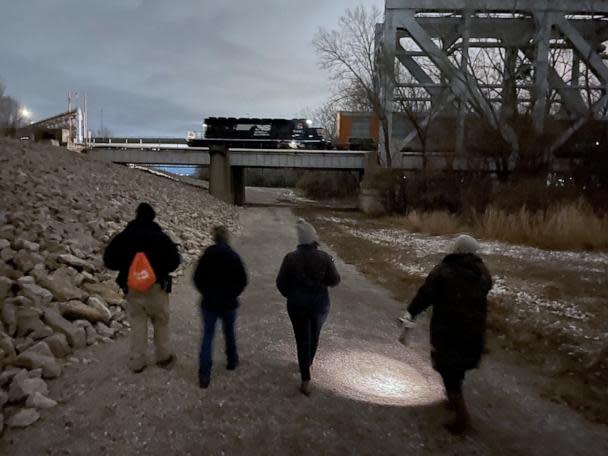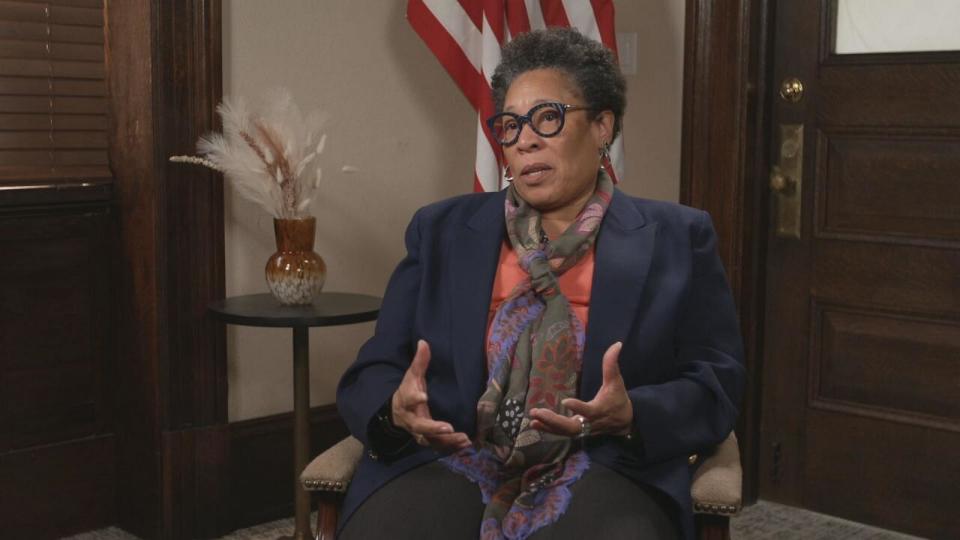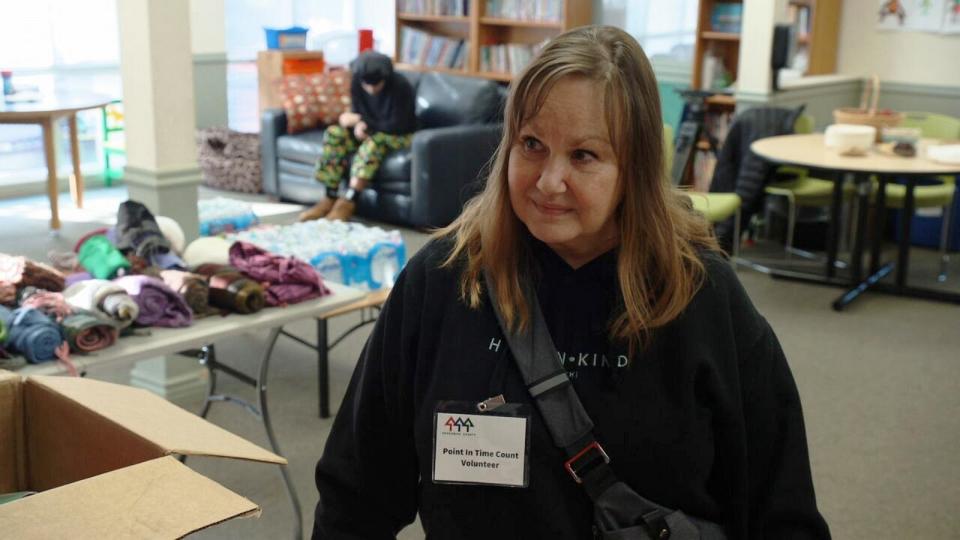'You can't be accurate': Annual count of US homeless population misses large numbers of people, experts warn

Thousands of volunteers across the country spent a night in January canvassing their communities to look for people who may be experiencing homelessness, as part of the government's annual Point-in-Time count.
The count is required by the U.S. Department of Housing and Urban Development, and its results can be used alongside other factors to determine funding. But those estimates have often not been accurate, some experts told ABC News.
"We only have one day to get a snapshot of the homeless population," said Hannah Anderson with the YWCA, a Point-in-Time count organizer in Snohomish County, Washington. "You can't be accurate when you're counting people for one day."
An ABC News analysis found that methods and resources vary from community to community, producing an inconsistent, piecemeal account that even HUD acknowledges underestimates the number of unhoused people.
"The picture that HUD is getting, and that Congress is getting, and that the public is getting, isn't as clear as it could be and should be," said Eric Tars of the National Homelessness Law Center.
HUD Secretary Marcia Fudge told ABC News in an interview that the count is just a sampling of the country's homelessness crisis.
"It's not an exact science," she said, noting that if methodologies change from year to year, it could cause problems.
"There's no other way at this point for us to count all of the homeless people, so we just do a sample," she added.
Still, Fudge said HUD is considering ways to improve the process, noting that the agency does "believe that there are some better ways to do it."

On Monday, Fudge announced HUD's largest funding award of its kind: $3.1 billion to homeless services providers across the country that will fund more than 7,000 projects. The recipients entered HUD's funding competition last year with extensive applications that included their Point-in-Time count results, among other metrics.
'Doesn't seem like it makes much sense'
Homelessness experts and institutions have been raising concerns about the Point-in-Time count for years.
Still, guidance surrounding the count has remained largely the same since it was first implemented in the mid-2000s. At least every other year, each community receiving HUD funding must conduct a Point-in-Time count in January, a time when people may crowd into homes with friends or family as much as possible to escape the cold.
"We wish that we could do [Point-in-Time] count when homelessness is at its highest, which tends to be early fall," said Maggie Thomas, a homeless services provider in Kansas City, Missouri. "But HUD says we do it in January, so we do it in January."
HUD Secretary Fudge told ABC News she doesn't know why the agency requires the count to be conducted in January, but that it will continue this practice for the time being.
"It doesn't seem like it makes a lot of sense, because it's cold, it's hard to find people, people are inside," Fudge said. "But that's what has always historically been done. And we just continue to do it the way it's always been done."
Aside from the timing, not much is standardized about the count: Organizations gather the data in different ways, with some more prone to undercounting than others, advocates for the homeless say.
"The data may not be consistent across jurisdictions, or even within a single jurisdiction from year to year," Tars said. "That makes it a little bit more challenging to draw meaningful data and trends from what's collected."
Countless ways to count
ABC News and the ABC Owned Television Stations' data team reached out to hundreds of Point-in-Time count organizers across the country to get a clearer picture of the scale of homelessness – and how they measure it – in their communities.
Of the several dozen coordinators that answered, most said they relied on volunteers to conduct their counts and about one in 10 said they used only hired staff or temporary workers.
The number of people conducting the counts ranged from 15 in Huntsville, Alabama, to 1,500 in San Diego.
Even in regions comparable in population, the numbers of counters varied drastically. Suburban DuPage County, Illinois, and Bergen County, New Jersey, have almost the same population and relatively similar estimates of people experiencing homelessness. But while DuPage County has about 100 volunteers for its Point-in-Time counts, Bergen County has 20 to cover a similar area.
"They can only count as many people as they have eyes to count with," Tars said.
Most count organizers said they use surveys, and a third said they tally individuals who appeared to be living on the streets, often together with another method. About one in 10 said they estimate the number of people they aren't able to find based on the sample they count.
Volunteers in St. Charles County, Missouri, reach more people than they can on foot by calling everyone on their housing prioritization list.
Across the state, Thomas and her team outside Kansas City work with law enforcement to find people.
"They tend to know, even if we don't know, where homeless encampments are," Thomas said.
Some communities use technology like mapping software to assist in their counts. Broward County, Florida, even uses drones to find encampments.
At the same time, many communities don't have access to advanced technology and may not have the resources to search as thoroughly.
"The night that I was out we didn't count anybody," Tars said of one Philadelphia Point-in-Time count, adding that he drove through neighborhoods that typically have people experiencing homelessness. "We just couldn't see them from the windows of our cars, and so they didn't get counted."
Some groups are more likely to be missed in these counts, advocates say. These include people living outside, and those who are more likely to be incarcerated, such as Black men and other people of color. People experiencing homelessness in rural areas are also more vulnerable to undercounts, because they can be more difficult to find.
Oftentimes, Point-in-Time count organizers tell volunteers to avoid dark alleys, underpasses and parks for their own safety – but people experiencing homelessness are likely to stay in those places, especially in areas with laws criminalizing homelessness, advocates say.
In 2017, the National Homelessness Law Center published a report called, "Don't Count on it: How the HUD Point-in-Time Count Underestimates the Homelessness Crisis in America." The report cited estimates that the true scale of homelessness falls between 2.5 and 10.2 times what the Point-in-Time count suggests.
The report included recommendations for HUD to improve the count, like coordinating more consistent methods and using estimation techniques to address undercounts. Tars said he hasn't seen a direct response from HUD to the concerns raised in the report.
In 2020 and 2021, the U.S. Government Accountability Office made similar recommendations, including checking the quality of Point-in-Time count methodologies and giving communities more detailed instructions on using sampling techniques and administrative data to improve their counts' accuracy.
In an emailed statement to ABC News, a HUD spokesperson wrote that the agency has examined other suggestions, such as conducting a count more than once per year, but has determined that many of these ideas would require significantly more federal and local resources.
Of the organizations that responded to ABC's survey, just over a quarter said they regularly conduct or have previously conducted additional counts, either at a different time of year or to measure a specific subpopulation, such as youth experiencing homelessness.
For now, HUD says that the count "is the only national dataset that captures both people sleeping in shelters or temporary housing as well as people who are sleeping in unsheltered locations."
True scale of the problem
One community has developed its own way to try to count its homeless population more accurately. In Seattle, Owen Kajfasz uses administrative data from service providers and advanced research techniques to estimate the number of people experiencing homelessness on an average day over the course of a year.
In 2022, that number came out to 53,532 – nearly four times that year's Point-in-Time count of 13,700 people. While the organization still has to report the smaller number to HUD, Kajfasz said he uses the larger number in local and state communications and advocacy.
"It's really important to be able to look at what the true scale of the problem is so that we can better allocate resources to it," Kajfasz said.

Kajfasz added that homelessness is fundamentally a housing and economic problem.
"Homelessness, ultimately, is a pretty easy math equation," he said. "We have more people than housing units, so people cannot all be inside in homes."
Last week, Harvard researchers released a study finding that half of American renters – a record 22.4 million households – spent more than 30 percent of their income on housing in 2022. They also found that the country's supply of low-cost rentals dropped by about 23 percent over the last decade, with two million fewer units under $600 a month by 2022.
The outcome of this equation has been a sharp increase in homelessness: Despite accounting for only a fraction of true homelessness, Point-in-Time count estimates have been growing across the country in recent years.
Tars said the Point-in-Time count can help uncover patterns like the recent increase in homelessness, but that he hasn't seen a federal response to this trend.
"What good are these numbers in the first place, if Congress isn't going to react to them in the way and at the scale that we actually need to start pushing those numbers back down again?" Tars asked.
In an emailed statement to ABC News, a HUD spokesperson wrote that "HUD does use the Point-in-Time count as one data source to inform the President’s Budget requests to Congress, and it is also factored in alongside others as one of the data points used for some funding formulas."
But while the federal government provides resources for addressing homelessness, Fudge said it is up to local governments to implement solutions.
In Washington state, Gov. Jay Inslee said his administration is working to clear roadside encampments and get more people into emergency shelters. He told ABC News' Jaclyn Lee that the state's homelessness crisis stems from an influx of people and a lack of housing.
"We have had some zoning rules that were overly restrictive," Inslee said. "We've changed our zoning laws now where we have more places to actually build."
Homelessness is not a new problem in Washington, but Inslee said most residents didn't notice it in their daily lives until the last few years when it became more visible with encampments. Now, as people see more encampments, he said there is more public will to act.
"You have to sort of go with what the people feel," Inslee said.
'Their voices need to be heard too'
North of Seattle, volunteers in Snohomish County packed bags with coats and socks to hand out on a cloudy January day as they surveyed community members experiencing homelessness.
"Their voices need to be heard too," said Matt Lawrence of the YWCA.
For Mindy Woods, participating in the Point-in-Time count is personal.
"I was unhoused 12 years ago, and I've been in a YWCA shelter," she said. "This is why I do it."

Tars said it's important to make the Point-in-Time count more accurate, but "at the end of the day, what we need is Congress to act and get the resources to communities so that people aren't on the streets to be counted in the first place."
"Housing's a basic need," Woods said. "We are stronger as a community when everybody has a safe, stable place to call home."
'You can't be accurate': Annual count of US homeless population misses large numbers of people, experts warn originally appeared on abcnews.go.com


